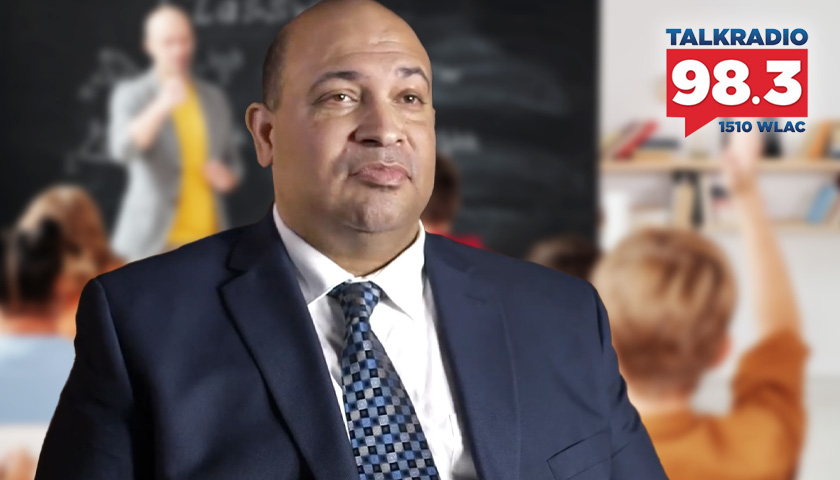Live from Music Row Friday morning on The Tennessee Star Report with Michael Patrick Leahy – broadcast on Nashville’s Talk Radio 98.3 and 1510 WLAC weekdays from 5:00 a.m. to 8:00 a.m. – host Leahy welcomed Phil Schwenk with American Classical Education charter schools in studio to discuss the next steps in the American Classical Education Charter School’s new Rutherford County location.
Leahy: In studio with us, a great educator, a good guy, Phil Schwenk. Phil’s with American Classical Education. And again, your background, you’ve been a teacher in Los Angeles Public Schools. Fill us in a little bit more about your background.
Schwenk: I’ve been in public education for almost 30 years now, which is still crazy for me to say, but yes.
Leahy: You started when you were two years old. (Laughs)
Schwenk: Exactly. (Chuckles)
Leahy: And don’t look a day older.
Schwenk: I started as a teacher in Los Angeles Unified School District. So that was the beginning of my teaching. I was a classroom teacher at the high school level for about 12 years, and I’ve been an administrator for close to 17, 18 years now. I was in both teaching and administration in LA and Cleveland.
I started a classical public charter school, like the ones we’re talking about in Toledo. I’ve been in and out; I’ve been all over different types of schools—everything from career tech ed to college prep, to urban, to suburban, and to rural. I’ve seen what you would expect to see in public education. So I’ve been around a while.
Leahy: But in terms of starting a classical public charter school, you have done that?
Schwenk: I have, yes.
Leahy: You have done that, and that’s what you’re going to do in Rutherford County. Is it the American Classical Academy of Rutherford?
Schwenk: Exactly. ACAR.
Leahy: We’re sitting here in the studio right now. How do you go about Phil? You’re smiling. You got a little bit over a year and four or five months. And people say that’s a long time, and yet you just got the green light. So how do you go about identifying a building, either buying a building or building a building, hiring the staff, and identifying a student? This looks like a pretty big task.
Schwenk: It is, but the fact that it’s a real task is exciting. This is the work I enjoy. I’ve been in the charter world for off and on for 20 years. So once you get a green light like this, it becomes a real thing. It’s no longer abstract. We’re not just talking about this ambiguous place that might happen.
Leahy: It goes from, it just might work! It goes from that to it’s going to happen.
Schwenk: Yes. Yes. So it’s what I call positive problems, and it’s a lot of work. So establishing the facility, for example it really starts, especially in situations like this, in deep discussion with the local educational agency and what are good places in the larger county to establish a school like this.
Leahy: Because there’s so much land available now in Rutherford County. (Laughs)
Schwenk: Exactly. That’s the reason why it’s so important to be in that discussion because it could be all of the above. It could be us having to build from the ground up, or it could be refurbishing a building. Obviously, the quicker we can come into that space, it helps us talk to families because families want to know where it is.
Leahy: They wanna have a physical building. But here’s the other part about this. You are going to start off with K-5 and 340 students. That’s year one, 2024. Do you build for K-12?
Schwenk: That’s the question. It could be just about you get a piece of land where you could have an entire facility, but you build only for those first populations and then expand over the next, three, four, or five years.
Leahy: How many acres do you need for this? (Laughs)
Schwenk: (Chuckles) It moves around. I think I’ve heard it like seven, 10 is usually ideal, but a lot of it, it depends on space. I’ve seen schools that are in very small spaces and schools that aren’t gigantic spaces.
As you said in Rutherford, there’s going to be a lot of dialogue as to the kind of space that you need. Generally speaking, when you think of schools, you can start thinking of like square footage of a building. So then you start getting into 30,000 plus and that kind of thing. Wherever you can fit, something like that is really a discussion.
Leahy: And I’m guessing, in terms of the design of the building, you are going to be looking at the security problems. I’m guessing there will be ballistic glass.
Schwenk: Yes.
Leahy: Where there are windows.
Schwenk: Yes. This is the opportunity to make the building, from the start, secure and safe for the kids.
Schwenk: Oh, absolutely. And as an educator, and like I said, I’ve worked in many situations, major cities and urban settings you have to have physical security to have school. And increasingly, that’s becoming the case no matter where you are. So yes, you need to create a facility where kids can come, and families can feel safe with their kids there so that we can focus on school. The sad reality is we have to do that.
Leahy: As you know there is a lot of growth in Rutherford County. It’s incredible. I guess it’s what, the fourth largest county in the state and growing?
Schwenk: And currently the fastest growing.
Leahy: Fastest growing by a long shot. Traffic. There’s a lot of traffic in Rutherford County. There are people right now listening to this program who are driving in on I-24, and they’re saying, yeah, you think there’s a lot of traffic? Now look right ahead of me right now on their face. This should be accessible to any Rutherford County, any K-12, and any K-5 student.
Schwenk: All students are invited, and it’s part of our work to make sure that all students can come.
Leahy: Is there a particular location in Rutherford County that is within a 45-minute drive for everybody in the morning? These are the things you’ve got to be looking at.
Schwenk: And that’s the discussion. As we get to know that area obviously the people who live there know it best. We just have kind of these larger macros. We need to have a building that all students have access to it and us making sure that there are routes to do that.
Are there areas in the county where the school needs to be closer to that area? And we’re open to that. Frankly, we just want to be able to serve the kids there. And any family that says, hey, we want to go to American Classical Academy in Rutherford, they should be able to come.
Leahy: I know you’ve been talking to parents. Will you continue to talk to parents about this new school, American Classical Academy, in Rutherford County?
Schwenk: This is a change in the conversation. It’s one thing to tell a parent that we might be having a school. It’s another thing to say we are having a school. So even the beginning of this discussion becomes the important part, and then the next question becomes where is it so that in the next couple months, that’s why we need to start securing that idea where it’s going to be so parents can start to think it over for the next year.
The conversation is ongoing and obviously increases as we get closer and closer to it becoming a reality. So in the next few months, you’ll start seeing meetings where parents can come together, learn about this school, ask questions, those types of things. For me, that’s the most fun part. I like talking about school.
Listen to today’s show highlights, including this interview:
– – –
Tune in weekdays from 5:00 – 8:00 a.m. to The Tennessee Star Report with Michael Patrick Leahy on Talk Radio 98.3 FM WLAC 1510. Listen online at iHeart Radio.
Photo “Phil Schwenk” by Northwest Ohio Classical Academy. Background Photo “Teacher and Students” by Max Fischer.





